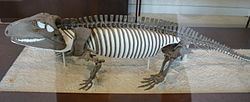Ophiacodontidae
| Ophiacodontidae Temporal range: Late Carboniferous to Early Permian 306–280 Ma |
|
|---|---|
 |
|
| Mounted skeleton of Ophiacodon retroversus in the American Museum of Natural History | |
| Scientific classification | |
| Kingdom: | Animalia |
| Phylum: | Chordata |
| Clade: | Synapsida |
| Family: |
†Ophiacodontidae Nopsca, 1923 |
| Subgroups | |
Ophiacodontidae is an extinct family of early eupelycosaurs from the Carboniferous and Permian. Archaeothyris, and Clepsydrops were among the earliest ophiacodontids, appearing in the Late Carboniferous. Ophiacodontids are among the most basal synapsids, an offshoot of the lineage which includes therapsids and their descendants, the mammals. The group became extinct by the Middle Permian, replaced by anomodonts, theriodonts, and the diapsid reptiles.
The lifestyle of ophiacodonts has long been controversial. Some studies suggested that they were semi-aquatic, and some even suggested a fairly aquatic lifestyle, but a recent study based on a quantitative inference model suggested that both Clepsydrops and Ophiacodon were terrestrial. Vertebral morphometric data also support, though ambiguously, a rather terrestrial lifestyle for Ophiacodon.Archaeothyris may also have been terrestrial, but no detailed study of its habitat has been performed so far. The earliest ophiacodontids resembled varanids in body proportions, while others were larger with elongated skulls and massive shoulder girdles, probably to provide muscle attachment to support the weight of the large head.
Traditionally, Archaeothyris, Ophiacodon, Varanosaurus and the briefly described Baldwinonus, Clepsydrops, Echinerpeton, Stereophallodon and Stereorhachis are included in the Ophiacodontidae. was also regarded as ophiacodontid, however there is debate as to whether or not it was a synapsid. Echinerpeton and Sterophallodon were included for the first time in a phylogenetic analysis by Benson (in press). Echinerpeton was found to be a wildcard taxon due to its small amount of known materials. It occupies three possible positions, falling either as the most basal synapsid, as the sister taxon of Caseasauria plus more derived taxa, or as an ophiacodontid more derived than Archaeothyris. Below is a cladogram modified from the analysis of Benson (in press), after the exclusion of Echinerpeton:
...
Wikipedia
